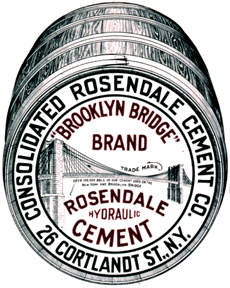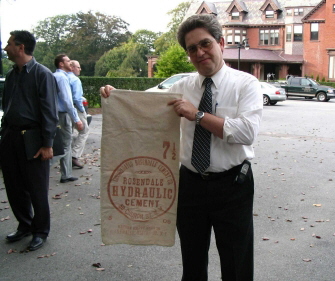|
NATURAL CEMENT HISTORY
Natural cement was first used in the United States in the late 18th Century. In 1825, commercial mining and processing operations were begun in an area in New Yorkís Hudson Valley, in and around the town of Rosendale in Ulster County. By 1830, nearly 10 million pounds per year of natural cement were being produced, marking the beginning of its commercialization. Several brands of natural cement quickly appeared on the market, produced from the regionís vast deposits of argillaceous limestone. Collectively they became known as Rosendale cements.
As the Industrial Revolution began, the need arose to more quickly construct large masonry buildings. Fast-setting Rosendale Natural Cement mortars proved more efficient than traditional mortars based on lime and sand. The advantages in construction of military fortifications were also soon realized, beginning the long-term use of Rosendale cement by the U. S. Army Corps of Engineers. By 1850 annual consumption of natural cement grew to more than 300 million pounds.
 Over the course of the 19th Century, the United States grew from a rural, agrarian economy to an urbanized industrial power. Early concrete, like the supports for the Brooklyn Bridge, began changing the face of American cities. Canals like the Delaware and Hudson helped to speed delivery of materials to their markets. Later, expansion of rail systems further accelerated transportation of passengers and goods. Construction of the Pennsylvania Railroad tunnels and Grand Central Station were part of that growth. In New York City, construction of the first light rail rapid transit system was beginning. All of these projects utilized Rosendale Natural Cements. Over the course of the 19th Century, the United States grew from a rural, agrarian economy to an urbanized industrial power. Early concrete, like the supports for the Brooklyn Bridge, began changing the face of American cities. Canals like the Delaware and Hudson helped to speed delivery of materials to their markets. Later, expansion of rail systems further accelerated transportation of passengers and goods. Construction of the Pennsylvania Railroad tunnels and Grand Central Station were part of that growth. In New York City, construction of the first light rail rapid transit system was beginning. All of these projects utilized Rosendale Natural Cements.
Nearly 3 billion pounds of natural cement were produced each year, in the 1890ís, and half of it came from Rosendale. But as the 20th Century began, demand was for still higher strength, and still faster curing cements. Natural cement usage was quickly overtaken and surpassed by Portland cement. Although Rosendale natural cements remained in use for special applications as late as the 1960ís, the last of the original Rosendale mining operations closed in 1970. For more than 30 years the material was no longer available.
 Edison Coatings, Inc. restarted production of Rosendale natural cement in 2004. Edisonís Rosendale Natural Cement Products are historically correct materials made from authentic, 100% Rosendale, New York natural cement rock. Edisonís Rosendale Natural Cement mortars, stuccos, grouts and concretes fully utilize the extensive engineering expertise developed in the use of natural cement in the 19th and 20th centuries. Edison Coatings, Inc. restarted production of Rosendale natural cement in 2004. Edisonís Rosendale Natural Cement Products are historically correct materials made from authentic, 100% Rosendale, New York natural cement rock. Edisonís Rosendale Natural Cement mortars, stuccos, grouts and concretes fully utilize the extensive engineering expertise developed in the use of natural cement in the 19th and 20th centuries.
PHOTO: October 2004: Edison Coatings President Michael Edison displays an original Rosendale cement bag at a recent restoration technology symposium.
PHOTO (Below): October 2004, Overhead clearance is limited in the upper stratum of the mine, so natural cement rock is removed using a Bobcat and a small dump truck.
Beyond the historical authenticity of Edisonís Rosendale Natural Cement, however, the material offers a unique balance of performance properties that can only be fully appreciated through the hindsight of nearly 2 centuries of durable service. Whether a project involves restoration of a building or structure originally constructed with natural cement, or simply would benefit from a highly compatible, durable, user-friendly cement technology, discover Rosendale Natural Cement products.
PHOTO: October 2004: Natural cement rocks, removed from different strata, are visibly different from each other in color. Edison Coatings has rediscovered and optimized the traditional methods of utilizing the various strata to produce the best and most consistent natural cements.
Photos courtesy Century House Historical Society..
|

